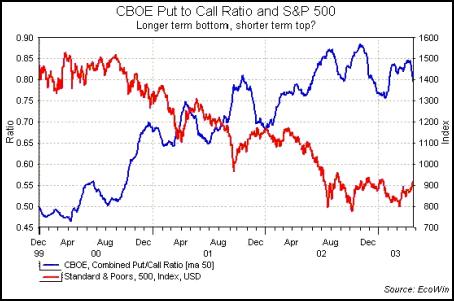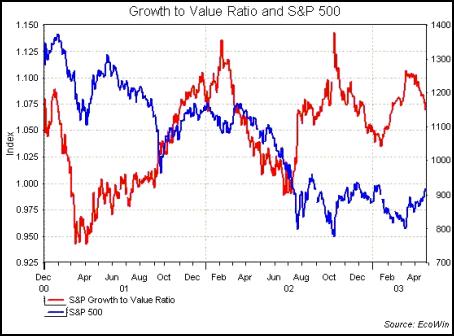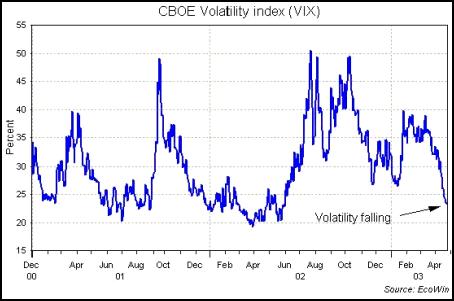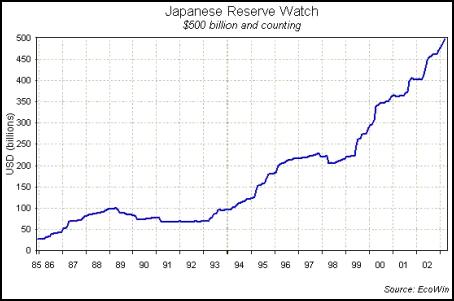SRA Commentary: A New Paradigm
A New Paradigm

Commentary
By Chris
Sanders
April 28, 2003
"Then back it comes, what in the sun was written,
Law and circumstance, each will is tried,
All simply forced, by obligation;
In the face of it, free will's tongue is tied.
Man's heart forswears what most was loved by him,
To iron "Must" comply both will and whim,
It only seems we're free, years hem us in,
Constraining more than at our origin."- J. W. von Goethe, Necessity, Everyman's Library, London 1999, 1125
"For the first time in forty years, the Federal Reserve Open Market Committee is not in a position where it should obviously desire inflation to be lower than its current rate."
- Vincent Reinhart, Director, Division of Monetary Affairs, Board of Governors of the US Federal Reserve in an address to the National Association of Business Economics, Washington Policy Conference, 24-25 March 2003


A New Paradigm
Equity markets have been having a pretty good April thanks to the "end" of the war in Iraq and the boyish enthusiasm of speculators coupled with the terror of everyone else that they will be left behind when the market takes off to the topside. For our own part, a more extended market rally would not be a real surprise given the massive amounts of liquidity that the Fed and the Bank of Japan are pumping into the world economy. On the other hand, the war clique in Washington appears to be well and truly entrenched in power. Its members have demonstrated no reluctance to describe, explain, and map out step by step their plan for permanent revolution on the Middle East, and have so far been sticking remarkably closely to the game plan. War and stock markets do not generally work well together. Why anyone thinks that they should this time around is a question begging for an answer.
Technical indicators are not particularly helpful. The put to call ration on the S&P 500 has climbed a lot since before the market peaked three years ago. It topped out in mid 2002 as the market bottomed. As the chart above shows, for all the angst associated with it, equities in the US have moved sideways now for some time. Just recently, the put to call ratio has fallen, even as the market took a breath and extended its post war rally. If the trading range of the last nine months stays in place, this should be counted a sell signal. On the other hand, the longer term imbalance in puts over calls is still quite pronounced, the market is still near its lows, and it hasn't managed to put in a positive year in the last three. These are good reason for being cautious about shorting it here.

If the market is really basing itself for a move higher, one would expect growth stocks to be putting in a better performance. The recent rally has seen value outperform, probably because it has been led by financials. Most commentary we have seen on this has interpreted the good stock performance and improving earnings at banks as…

…good news for the markets. Maybe that is the right way to look at it, but we are not so sure. The banks are making money because their trade association, also known as the Federal Reserve, has kept the yield curve steep. This is money for old rope, and merely serves to blind the curious and to lull the gullible into thinking that all is right. That is not to say it is not, but the banks are not doing well because the economy is doing especially well. They are dong well because the Fed is ensuring that its principle shareholders make money. That is not meant to be cynical; it is after all what the Fed is paid to do. The banks are also doing well thanks to the still-strong housing market, but this is essentially the same phenomenon as the steep yield curve, which has depended on low rates to stay steep.
Market volatility has been falling like a stone in recent weeks, which is another caution against immediate bullishness. The market generally likes to rally from positions of extreme fear. As measured by volatility, even during the Iraq campaign this did not get very far out of hand. The speed with which it is dropping now is consistent with the fall in the put to call ratio that we discussed above, and is reflected as well in sentiment indicators. The American Association of Individual Investors Sentiment survey reported in Barrons Online last week has shot up like a rocket. This is supported by directionally similar if not as enthused moves in the Market Vane and Consensus Index surveys, as well as last Friday' University of Michigan consumer survey, which bounced strongly. The real message here, we think, is the volatility in sentiment itself. The herd is thundering back and forth in the pen. That does not make for good decision making, and it suggests that any directional move in the market, up or down, is very soft.

First quarter GDP,
released last Friday, ran at a 1.6% annualised rate, which
considering the heavy headwind it faces from a current
account deficit of 5% of GDP, represents a whopping domestic
demand figure of 6.6%. Under "normal" circumstances, this
would be setting off the sirens in the interest rate futures
pits, but that is not happening now. One does not have to
look far for the reason, which is the massive growth in
federal borrowing that must be financed. The Fed cannot risk
flattening the yield curve by much if the banks are to be
encouraged to buy Treasuries.
This points to the elemental contradiction in contemporary economic policy, which is that the economy won't grow without borrowing more from abroad, but the more it borrows, the stronger domestic demand growth has to be in order to avoid recession. If one were starting from a basically balanced external position, this would be no trouble at all. But to start from a position of net foreign debt of 30% of GDP with an annual growth rate of 5% of GDP is a heavy handicap. That handicap is going to get heavier, and it is not at all unreasonable to see net foreign debt and the current account deficit climbing to 60% and 8% of GDP respectively in very little time at all.
The only way (that we can see, at least) for this to be accomplished from a policy standpoint is for the Fed to accelerate its monetisation of Treasuries and to take what it euphemistically calls unconventional measures, which are basically monetisation by another name.

It is not inconceivable for the equity market to rally under these circumstances, but investors should be clear about the underpinnings of the rally. Ironically, financials, especially the largest US banks, could actually be considered value stocks, or at least safe havens. Apart from the fact that they are for all intents and purposes government backed, they are also among the few actors in the economy that will benefit from the inflation that we believe is in the pipeline. Funding themselves in the wholesale market, they can simply pass the higher interest costs along to the public.
There is precedent for this. As we have often discussed over the last few years, during the 70s a similar situation pertained. The banks did rather well out of it, as did the housing market, which provided the public with one of the few hedges against the double digit inflation late in the decade. Credit demand stayed strong, as the demand for housing moved from being driven by need to being driven by fear. The problem with extrapolating from that experience to the present is, however, America's net foreign debt. When Reagan was elected in 1980, the US external position was in balance. There were consequently no impediments to the US borrowing from abroad. Today, the situation could not be more different. Now the question is how much more American debt will the rest of the world accept before it gags.
This brings us back from markets to politics. Markets need a minimum level of transparency and disclosure to operate properly, so that investors are able to make decisions with an acceptable degree of confidence. In short, investors need to make their own mistakes. Anything less than this means that markets cannot perform their essential function, which is to clear risk.
Today we are perilously close to the line between an acceptable and unacceptable degree of transparency. Indeed, we may have already crossed that line. This was always bound to be a problem at some point given the nature of the international banking system, which is built around a group of central banks, which themselves orbit the Federal Reserve. Central banking, as we never tire of pointing out, only works if the central bankers are able to do their job with a minimum of political interference. Since there is nothing so political as money, this was always going to be impossible, so the integrity of the system depends completely on the willingness of the market to accept the fiction of political independence. For this to work, it does mean that there are times when the central banks simply have to do what is "right."
There is little that we can see
today to suggest that the Fed or other central banks are
adhering to this pragmatic working principle. On the
contrary, their actions speak far louder than their words.
Instead of promoting transparency, which would go a long way
to instilling confidence, they central banks and their
political masters are doing exactly the opposite. There is
no better illustration of this than their machinations in
the gold market. From the forced retirement of the public
share issue at the BIS to the cryptic redesignation of gold
held in US vaults as "deep storage," the central banks have
done everything in their power to conceal the fact and the
extent of the expatriation of national gold reserves. In the
most recent issue of Freemarket Gold and Money Report
This is interesting because it hints at the
involvement of the BIS, which is not a big deal on the face
of it but for one reason: BIS operations are no longer
transparent because of the forced retirement of the public
share issue. The timing of that change at the BIS three
years ago, the assumption by the United States of two board
seats and the admission of Japan and Canada to the board
circumstantially support the idea that at least part of
national reserves are being expatriated to an international
private institution. To see the point, it is necessary to
understand that the decline in the gold price in the late
90s would not have happened without the willing supply of
liquidity to short sellers in the gold market by the central
banks. The most active and biggest of those short sellers
were the largest hedge funds, bank proprietary desks, and
some of the producers themselves, notably Barrick. From the
public's standpoint, this is tantamount to saying that it
was industry insiders who profited from the gold short
trade. The billion dollar question today is therefore who
is the beneficial owner of that gold and exactly where is
it? We don't know, but it feels very much as though a
reorganisation of the international monetary system is going
on right under our noses. That is no advertisement to buy
stocks, dollars or anything else, except of course for gold,
which is the only ticket available. When the train moves out
of the station, we want to be on it too.


 Martin LeFevre - Meditations: In A Global Society, There Is No Such Thing As “National Security”
Martin LeFevre - Meditations: In A Global Society, There Is No Such Thing As “National Security” Binoy Kampmark: Secrecy And Virtue Signalling - Another View Of Signalgate
Binoy Kampmark: Secrecy And Virtue Signalling - Another View Of Signalgate Gordon Campbell: On The Americanising Of NZ’s Public Health System
Gordon Campbell: On The Americanising Of NZ’s Public Health System Ian Powell: Trumpian Health Leadership
Ian Powell: Trumpian Health Leadership Eugene Doyle: Disruption - Historians Challenge Russophobic Propaganda
Eugene Doyle: Disruption - Historians Challenge Russophobic Propaganda Ramzy Baroud: War, Doublethink, And The Struggle For Survival - Geopolitics Of The Gaza Genocide
Ramzy Baroud: War, Doublethink, And The Struggle For Survival - Geopolitics Of The Gaza Genocide